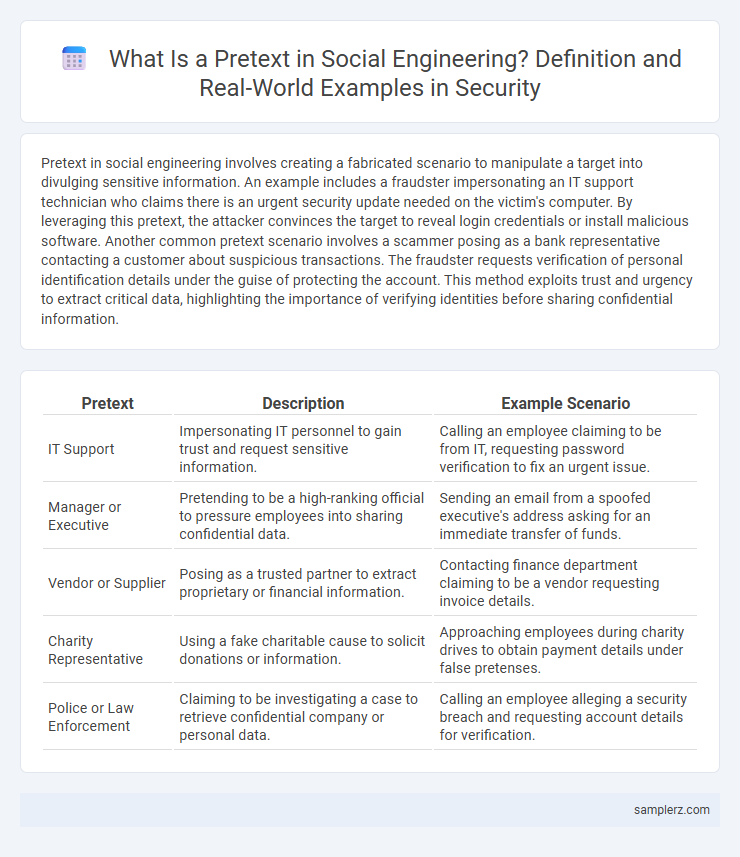Pretext in social engineering involves creating a fabricated scenario to manipulate a target into divulging sensitive information. An example includes a fraudster impersonating an IT support technician who claims there is an urgent security update needed on the victim's computer. By leveraging this pretext, the attacker convinces the target to reveal login credentials or install malicious software. Another common pretext scenario involves a scammer posing as a bank representative contacting a customer about suspicious transactions. The fraudster requests verification of personal identification details under the guise of protecting the account. This method exploits trust and urgency to extract critical data, highlighting the importance of verifying identities before sharing confidential information.
Table of Comparison
| Pretext | Description | Example Scenario |
|---|---|---|
| IT Support | Impersonating IT personnel to gain trust and request sensitive information. | Calling an employee claiming to be from IT, requesting password verification to fix an urgent issue. |
| Manager or Executive | Pretending to be a high-ranking official to pressure employees into sharing confidential data. | Sending an email from a spoofed executive's address asking for an immediate transfer of funds. |
| Vendor or Supplier | Posing as a trusted partner to extract proprietary or financial information. | Contacting finance department claiming to be a vendor requesting invoice details. |
| Charity Representative | Using a fake charitable cause to solicit donations or information. | Approaching employees during charity drives to obtain payment details under false pretenses. |
| Police or Law Enforcement | Claiming to be investigating a case to retrieve confidential company or personal data. | Calling an employee alleging a security breach and requesting account details for verification. |
Common Pretexts Used in Social Engineering Attacks
Common pretexts used in social engineering attacks often involve impersonating authority figures such as IT support or company executives to gain trust and elicit sensitive information. Attackers may pose as trusted employees requesting password resets or confidential data, exploiting the target's sense of urgency or curiosity. These deceptive tactics are designed to bypass technical defenses by manipulating human psychology and social norms.
Classic Examples of Pretexting Scenarios
Classic examples of pretexting scenarios in social engineering often involve attackers impersonating IT support personnel to extract login credentials from unsuspecting employees. Another common pretext includes posing as bank representatives to obtain sensitive financial information or personal identification numbers. These tactics exploit trust and authoritative roles to manipulate targets into revealing confidential data.
Pretexting Techniques in Corporate Espionage
Pretexting techniques in corporate espionage often involve impersonating trusted employees or executives to gain unauthorized access to sensitive information. Attackers create detailed backstories and manipulate social cues to exploit human psychology, bypassing standard security measures. This method leverages social engineering tactics such as fake credentials, urgent requests, and fabricated scenarios to infiltrate organizations and extract proprietary data.
Pretext-Based Phishing Attacks Explained
Pretext-based phishing attacks involve crafting a believable scenario to manipulate victims into revealing sensitive information, such as login credentials or financial details. Attackers often impersonate trusted figures like IT support, bank officials, or company executives, using carefully constructed dialogues to gain the target's trust. This type of social engineering exploits human psychology by creating urgency or authority, making it a highly effective phishing strategy.
Real-World Cases of Pretexting in Social Engineering
In social engineering, pretexting often involves attackers impersonating trusted individuals or entities to extract sensitive information. Real-world cases include the 2011 RSA Security breach, where attackers posed as IT staff to gain access credentials, and the 2013 Snapchat data leak caused by pretexting customer support representatives. These incidents highlight the critical need for robust identity verification and employee awareness training to prevent successful pretexting attacks.
How Attackers Craft Convincing Pretexts
Attackers craft convincing pretexts in social engineering by thoroughly researching their targets, often using publicly available information from social media profiles, corporate websites, and data breaches. They create believable scenarios, such as posing as IT support or trusted colleagues, to manipulate victims into divulging sensitive information or performing unauthorized actions. These tailored pretexts exploit psychological triggers like authority, urgency, and trust to increase the success rate of attacks.
Pretexting Tactics in Telephone Scams
Pretexting tactics in telephone scams often involve impersonating trusted figures such as bank officials or IT support to extract sensitive information. Scammers create urgent scenarios, like claiming account issues or security breaches, to pressure victims into divulging passwords or personal data. Leveraging familiarity and authority, these fraudsters manipulate social engineering principles to bypass standard security protocols effectively.
Social Media Manipulation Through Pretexting
Social media manipulation through pretexting involves attackers creating fake personas or scenarios to gain trust and extract sensitive information from targets. By posing as trusted contacts or authority figures on platforms like Facebook or LinkedIn, threat actors exploit personal connections and use fabricated stories to bypass security measures. This method often leads to credential theft, unauthorized access, and data breaches due to the victim's lowered defenses in familiar social environments.
Pretexting for Physical Security Breaches
Pretexting for physical security breaches involves attackers creating a fabricated scenario to gain unauthorized access to restricted areas. For example, an intruder might pose as a maintenance technician requesting entry to sensitive facilities to perform urgent repairs, bypassing standard security protocols. Employees trained to verify identities and validate requests can significantly reduce the risk of successful pretexting attacks in physical security contexts.
Recent Trends in Pretexting Methods
Recent trends in pretexting methods reveal attackers increasingly impersonate trusted entities like IT support or government officials to manipulate victims into revealing sensitive information. Sophisticated scenarios now exploit COVID-19 concerns, offering fake health updates or vaccine appointments to gain access to personal data. Leveraging authentic-looking emails and urgent communication tactics, these pretexts evolve rapidly to bypass traditional security filters.

example of pretext in social engineering Infographic
 samplerz.com
samplerz.com